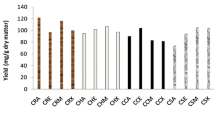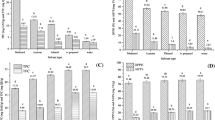Abstract
Extracts of brown lead (Leucaena leucocephala) seed prepared using different extraction solvents were determined for antioxidative activities using different assays. The highest yield (3.4–4.0%) was obtained when water was used as an extraction solvent, compared with all ethanolic extracts used (1.2–2.0 %) (P < 0.05). Much lower chlorophyll content was found in the water extract. When hot water was used, the resulting extract contained lower total phenolic and mimosine contents (P < 0.05). In general, 60–80 % ethanolic extracts had higher 2,2-diphenyl-1-picrylhydrazyl (DPPH), 2,2-azino-bis(3-ethylbenzothiazoline-6-sulfonic acid) (ABTS) radical scavenging activities, ferric reducing antioxidant power (FRAP) and metal chelating activity than water extracts (P < 0.05). When brown lead seed was dechlorophyllised prior to extraction, the water extract had slightly increased yield with lower chlorophyll content. Nevertheless, prior chlorophyll removal resulted in the increase in antioxidative activities but lower total phenolic and mimosine contents (P < 0.05). Generally, phenolic compounds and mimosine were more released when water was used as the extraction solvent, while the lower amount of chlorophyll was extracted. Oven-drying exhibited the negative effect on antioxidative activities and mimosine content. The higher antioxidative activities with concomitant higher total phenolic and mimosine contents were found in water extract dried by freeze drying. Thus, extraction solvent, dechlorophyllisation and drying methods directly influenced the yield and antioxidative activity of lead seed extract.



Similar content being viewed by others
References
Abascal K, Ganora L, Yarnell E (2005) The effect of freeze drying and its implications for botanical medicines: a review. Phytother Res 19:655–660
Antolovich M, Prenzler PD, Patsalides E, McDonald S, Robards K (2002) Methods for testing antioxidant activity. Analyst 127:183–198
AOAC (2000) Official methods of analysis, 17th edn. Association of Official Analytical Chemists, Gaithersberg
Arnao MB, Cano A, Acosta M (2001) The hydrophilic and lipophilic contribution to total antioxidant activity. Food Chem 73:239–244
Benzie IFF, Strain JJ (1996) The ferric reducing ability of plasma (FRAP) as a measure of antioxidant power the FRAP assay. Anal Biochem 239:70–76
Boyer RF, McCleary CJ (1987) Superoxide ion as a primary reductant in ascorbate-mediated ferritin iron release. Free Rad Biol Med 3:389–395
Budi T, Brian LB, Ron BHW (2006) Optimisation of conditions for the degradation of mimosine in Leucaena leucocephala leaf. J Sci Food Agric 35:63–616
Cartea ME, Marta F, Pilar S, Pablo V (2011) Phenolic compounds in Brassica vegetables. Molecules 16:251–280
Chanwitheesuk A, Teerawutgulrag A, Rakariyatham N (2005) Screening of antioxidant activity and antioxidant compounds of some edible plants of Thailand. Food Chem 92:491–497
Daniel DL, Huerta BEB, Sosa IA, Mendoza MGV (2012) Effect of fixed bed drying on the retention of phenolic compounds, anthocyanins and antioxidant activity of roselle (Hibiscus sabdariffa L.). Ind Crops Prod 40:268–276
Danilewicz JC (2003) Review of reaction mechanisms of oxygen and proposed intermediate reduction products in wine: central role of iron and copper. Am J Enol Vitic 54:73–85
Echeverria V, Belmar R, Ly J, Santos-Ricalde RH (2002) Effect of Leucaena leucocephala leaf meal treated with acetic acid or sodium hydroxide on apparent digestibility and nitrogen retention in pig diets. Anim Feed Sci Technol 101:151–159
Edenharder R, Grunhage D (2003) Free radical scavenging abilities of flavonoidsas mechanism of protection against mutagenicity induced by ter-butyl hydroperoxide or cumene hydroxide in Salmonella typhimurium TA102. Mutat Res Genet Toxicol Environ Mutagen 504:1–18
Erickson AJ, Ramsewak RS, Smucker AJ, Nair MG (2000) Nitrification inhibitors from the roots of Leucaena leucocephala. J Agric Food Chem 48:6174–6177
Ferruzzi MG, Bohm V, Courtney PD, Schwartz SJ (2002) Antioxidant and antimutagenic of dietary chlorophyll derivatives determination by radical scavenging and bacterial reverse mutagenesis assays. J Food Sci 67:2589–2595
Frankel EN (1998) Antioxidants. In: Lipid oxidation, 1st edn. The Oily Press, Dundee, p 303
Hagerman AE, Riedl KM, Jones GA, Sovik KN, Ritchard NT, Hartzfeld PW, Riechel TL (1998) High molecular weight plant polyphenolics (tannins) as biological antioxidants. J Agric Food Chem 46:1887–1892
Hamrouni-Sellami I, Rahali FZ, Rebey IB, Bourgou S, Limam F, Marzouk B (2012) Total phenolics, flavonoids, and antioxidant activity of sage (Salvia officinails L.) plants as affected by different drying methods. Food Bioprocess Technol. doi:10.1007/s11947-012-0877-7
Kahkonen MP, Hopia AI, Vuorela HJ, Rauha JP, Pihlaja K, Kujala TS, Heinonen M (1999) Antioxidant activity of plant extracts containing phenolic compounds. J Agric Food Chem 47:3954–3962
Kamada Y, Oshiro N, Oku H, Hongo F, Chinen I (1997) Mimosine toxicity in broiler chicks fed Leucaena leucocephala seed powder. Anim Sci Technol 68:121–130
Lalitha K, Kulothungan SR (2006) Selective determination of mimosine and its dihydroxypyridinyl derivative in plant systems. Amino Acids 31:279–287
Lalitha K, Vargheese CM, Balasubramanian N (1993) Spectrophotometric determination of mimosine and 3-nydroxy-4-(1H)-pyridone—the toxic principles of Leucaena leucocephala. Anal Biochem 213:57–62
Lanfer-Marquez UM, Barros RMC, Sinnecker P (2005) Antioxidant activity of chlorophylls and their derivatives. Food Res Int 38:885–891
Lefsrud M, Kopsell D, Sams C, Wills J, Both AJ (2008) Dry matter content and stability of carotenoids in kale and spinach during drying. Horticulture 43:1731–1736
Leong LP, Shui G (2002) An investigation of antioxidant capacity of fruits in Singapore markets. Food Chem 76:69–75
Liao K, Yin M (2000) Individual and combined antioxidant effects of seven phenolic agents in human erythrocyte membrane ghosts and phosphatidylcholine liposome systems: importance of the partition coefficient. J Agric Food Chem 48:2266–2270
Lin SD, Sung JM, Chen CL (2011) Effect of drying and storage conditions on caffeic acid derivatives and total phenolics of Echinacea Purpurea grown in Taiwan. Food Chem 125:226–231
Loganayaki N, Siddhuraju P, Manian S (2011) Antioxidant activity and free radical scavenging capacity of phenolic extracts from Helicteres isora L. and Ceiba pentandra L. J Food Sci Technol. doi:10.1007/s13197-011-0389-x
Lowery JB, Cook N, Wilson RD (1984) Flavonol glycoside distribution in cultivars and hybrids of Leucaena leucocephala. J Sci Food Agric 35:401–407
Maqsood S, Benjakul S (2010) Comparative studies of four different phenolic compounds on in vitro antioxidative activity and the preventive effect on lipid oxidation of fish oil emulsion and fish mince. Food Chem 119:123–132
Medina I, Gallardo JM, Gonzaalez MJ, Lois S, Hedges N (2007) Effect of molecular structure of phenolic families as hydroxycinnamic acids and catechins on their antioxidant effectiveness in minced fish muscle. J Agric Food Chem 55:3889–3895
Naczk M, Shahidi F (2004) Extraction and analysis of phenolics in food. J Chromatogr A 1054:95–111
Nirmal NP, Benjakul S (2011) Inhibition of melanosis formation in Pacific white shrimp by the extract of lead (Leucaena leucocephala) seed. Food Chem 128:427–432
Pinela J, Barros L, Carvalho AM, Ferreira ICFR (2011) Nutritional composition and antioxidant activity of four tomato (Lycopersicon esculentum L.) farmer’ varieties in Northeastern Portugal homegardens. Food Chem Toxicol 50:829–834
Poonam S, Pushpa RK (1995) Leucaena leucocephala A nutrition profile. Food Nutr Bull 16:234–237
Prior RL, Wu XL, Schaich K (2005) Standardized methods for the determination of antioxidant capacity and phenolics in food and dietary supplements. J Agric Food Chem 53:4290–4302
Puchala R, Davis JJ, Sahlu T (1996) Determination of mimosine and 3,4-dihydroxypyridine in milk and plasma of goats. J Chromatogr B Biomed Appl 685:375–378
Row KH, Jin Y (2006) Recovery of catechin compounds from Korean tea by solvent extraction. Biores Technol 97:790–793
Sahlu T, Puchala R, Reis PJ, Davis JJ, Tesfai K, Fernandez JM, Millamena AA (1995) Technical note: tissue residues of mimosine and 2, 3-dihdroxypyridine after intravenous infusion in goats. J Anim Sci 73:172–176
Sang SY, Jamharee F, Prasad KN, Azlan A, Maliki N (2011) Influence of drying treatments on antioxidant capacity of forage legume leaves. J Food Sci Technol. doi:10.1007/s13197-001-0596-5
Sartory DP, Grobbelaar JU (1984) Extraction of chlorophyll a from freshwater phytoplankton for spectrophotometric analysis. Hydrobiologia 14:177–187
Shimada K, Fijikawa K, Yahara K, Nakamura T (1992) Antioxidative properties of xanthan on the autoxidation of soybean oil in cyclodextrin emulsion. J Agric Food Chem 40:945–948
Siddhuraju P, Becker K (2007) The antioxidant and free radical scavenging activities of processed cowpea (Vigna unguiculata L.) seed extracts. Food Chem 101:10–19
Slinkard K, Singleton VL (1977) Total phenol analysis: automation and comparision with manual methods. Am J Enol Vitic 28:49–55
Soedarjo M, Hemscheidt TK, Borthakur D (1994) Mimosine, a toxin present in leguminous trees (Leucaena spp.), induces a mimosine-degrading enzyme activity in some Rhizobium strains. Appl Environ Microbiol 60:4268–4272
Steel RGD, Torrie JH (1980) Principle and procedures of statistics: A biometrical approach. McGraw-Hill, New York.
Sultana B, Anwar F, Przybylski R (2007) Antioxidant activity of phenolic components present in barks of Azadirachta indica, Terminalia arjuna, Acacia nilotica, and Eugenia jambolana Lam. trees. Food Chem 104:1106–1114
Velioglu YS, Mazza G, Gao L, Oomah BD (1998) Antioxidant activity and total phenolics in selected fruits, vegetables, and grain products. J Agric Food Chem 46:4113–4117
Vellingiri M, Deiva M, Teepica P, Jagathala MS (2011) Effects of processing conditions on the stability of polyphenolic contents and antioxidant capacity of Dolichos lablab L. J Food Sci Technol. doi:10.1007/s13197-011-0387-z
Wills RBH, Tangendjaja B (1981) Effect of pH and temperature on the degradation of mimosine and 3-hydroxy-4(1H)-pyridone. Phytochem 20:2017–2018
Wu HC, Chen HM, Shiau CY (2003) Free amino acid and peptide as related to antioxidant properties in protein hydrolysates of mackerel (Scomber austriasicus). Food Res Int 36:949–957
Yasuko S, Michael FC, Stephen CG, Hideo Y (2002) Plant phenolic antioxidant and prooxidant activities: phenolics-induced oxidative damage mediated by metals in plants. Toxicol 177:67–80
Acknowledgments
Authors would like to thank the Graduate School, Prince of Songkla University for the financial support.
Author information
Authors and Affiliations
Corresponding author
Rights and permissions
About this article
Cite this article
Benjakul, S., Kittiphattanabawon, P., Sumpavapol, P. et al. Antioxidant activities of lead (Leucaena leucocephala) seed as affected by extraction solvent, prior dechlorophyllisation and drying methods. J Food Sci Technol 51, 3026–3037 (2014). https://doi.org/10.1007/s13197-012-0846-1
Revised:
Accepted:
Published:
Issue Date:
DOI: https://doi.org/10.1007/s13197-012-0846-1




